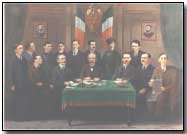County Dublin Coat of Arms
County Dublin (Irish: Contae Bhaile Átha Cliath or Contae Átha Cliath) is a county in Ireland. It is part of the Dublin Region and is in the province of Leinster. It is named after the city of Dublin, which is the capital of Ireland. County Dublin was one of the first parts of Ireland to be shired by King John of England following the Norman invasion of Ireland. The area of the county no longer has a single local authority; local government is now split between three authorities. The population of the county at large, which includes Dublin city, was 1,270,603 according to the census of 2011.[1]
It is no longer used for local government purposes in Ireland. In 1994, the administrative county (which did not include the county borough of Dublin) was dissolved and the area divided among the administrative counties of Dún Laoghaire–Rathdown, Fingal and South Dublin each with its county seat. To these areas may be added the area of Dublin city which collectively comprise the Dublin Region (Réigiúin Átha Cliath) and come under the remit of the Dublin Regional Authority.
The area lost its administrative county status in 1994, with Section 9 Part 1(a) of the Local Government (Dublin) Act, 1993 stating that "the county shall cease to exist." At that time, and in response to a European Council report highlighting Ireland as the most centralised country in the European Union, it was decided that a single County Dublin was unmanageable and undemocratic from a local government perspective. In discussing the legislation to dissolve Dublin County Council, Avril Doyle TD said, "The Bill before us today effectively abolishes County Dublin, and as one born and bred in these parts of Ireland I find it rather strange that we in this House are abolishing County Dublin. I am not sure whether Dubliners realise that that is what we are about today, but in effect that is the case."
Despite the legal status of the Dublin Region, the term "County Dublin" is still in common usage. Many organisations and sporting teams continue to organise on a "County Dublin" or "Dublin Region" basis. The area formerly known as "County Dublin" is now defined in legislation solely as the "Dublin Region" under the Local Government Act, 1991 (Regional Authorities) (Establishment) Order, 1993, and this is the terminology officially used by the four Dublin administrative councils in press releases concerning the former county area. The term Greater Dublin Area, which might consist of some or all of the Dublin Region along with counties of Kildare, Meath and Wicklow, has no legal standing.
The latest Ordnance Survey Ireland "Discovery Series" (Third Edition 2005) 1:50,000 map of the Dublin Region, Sheet 50, shows the boundaries of the city and three surrounding counties of the region. Extremities of the Dublin Region, in the north and south of the region, appear in other sheets of the series, 43 and 56 respectively.
There are 10,469 Irish speakers in County Dublin attending the 31 Gaelscoils (Irish language primary schools) and eight Gaelcholáiste (Irish language secondary schools). There may be up to another 10,000 Irish speakers from the Gaeltacht living and working in Dublin also.
There are four local authorities whose remit collectively encompasses the geographic area of the county and city of Dublin.
| Name | Area | Population | |
|---|---|---|---|
| 1 | Dublin City | 114.99 km2 (44.40 sq mi) | 525,383 |
| 2 | Dún Laoghaire–Rathdown | 127.31 km2 (49.15 sq mi) | 206,995 |
| 3 | Fingal | 454.60 km2 (175.52 sq mi) | 273,051 |
| 4 | South Dublin | 222.74 km2 (86.00 sq mi) | 265,174 |
Prior to the enactment of the Local Government (Dublin) Act 1993, the county was a unified whole even though its was administered by two local authorities - Dublin County Council and Dublin Corporation. Since the enactment of the Local Government Act 2001 in particular, the geographic area of the county has been divided between three entities at the level of "county" and a further entity at the level of "city". They rank equally as first level local administrative units of the NUTS 3 Dublin Region for Eurostat purposes. There are 34 LAU 1 entities in the Republic of Ireland. Each local authority is responsible for certain local services such as sanitation, planning and development, libraries, the collection of motor taxation, local roads and social housing.
The county is part of the Dublin constituency for the purposes of European elections. For elections to Dáil Éireann, the area of the county is today divided into twelve constituencies: Dublin Central, Dublin Mid–West, Dublin North, Dublin North–Central, Dublin North–East, Dublin North–West, Dublin South, Dublin South–Central, Dublin South–East, Dublin South–West, Dublin West and Dún Laoghaire. Together they return 47 deputies (TDs) to the Dáil.
Media in County Dublin
- The local radio stations include 98FM, FM104, 103.2 Dublin City FM, Dublin's Q102, Spin 1038, Dublin's Country Mix 106.8, Phantom 105.2 and Radio Nova.
- The local newspapers include Dublin Penny Journal, The Echo, The Northside People, The Southside People, Liffey Champion and The Metro Herald.
Transportation in County Dublin
- Road: The major roads are the N2, N3, N4 and N7 national primary roads, and the M1, M11 and M50 motorways.
- Heavy rail: The InterCity and Commuter rail services (Iarnród Éireann).
- Light rail: The Luas tram system serving Dublin City and its suburbs.
- Rapid transit: The DART and the proposed Dublin Metro line.
- Port: Dublin Port and Dún Laoghaire Harbour.
- Air: Dublin International Airport.


No comments:
Post a Comment